Discover the 8 quintessential Irish dishes that belong on your Ireland itinerary, from hearty stews to traditional bread. Travel tips from local experts for responsible and breathtaking experiences.
Gone are the days of dismissing cuisine in Ireland as just “meat and potatoes.” Modern chefs and passionate local producers are reviving ancient recipes and elevating classic dishes with farm-to-table ingredients. At Cerca our mission is to eat our way across the world and Ireland is one of the most rewarding places to dive deep into culinary tradition.
Yes, corned beef and cabbage, Irish cheddar, Guinness. But what else? From Dublin’s Michelin-starred restaurants to Galway’s bustling market stalls, and the hidden gems tucked into the rolling countryside, food in Ireland is as much about culture and history as it is about taste. Here are eight essential Irish dishes that will help steep you into the context of this grand, green country.
1. Irish Stew (Stobhach Gaelach)
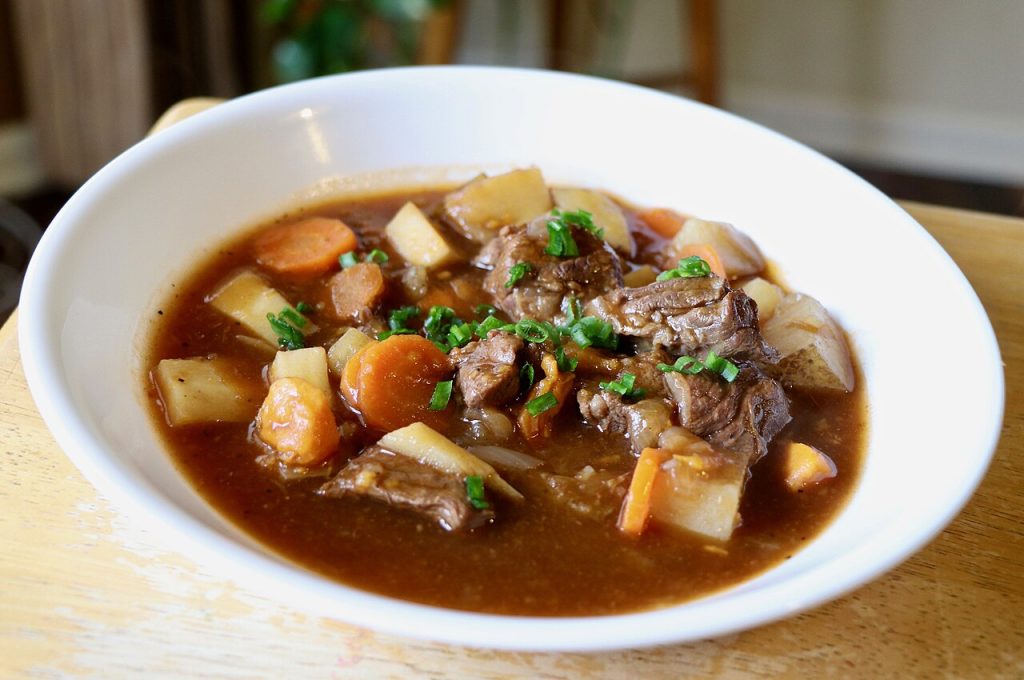
The Heart and Soul of Irish Cuisine
Few dishes are as intrinsically linked to Ireland as a bowl of steaming, slow-cooked Irish stew. This humble dish has been fueling farmers, fishermen, and rebels alike for centuries. Traditionally made with lamb or mutton, potatoes, onions, and carrots, it’s a one-pot wonder that perfectly encapsulates the simplicity and heartiness of Irish cooking.
This hearty, one-pot meal dates back to at least the 17th century, though its origins likely stretch further. Early Irish stew was made with whatever meat was on hand, though mutton (older sheep) was the most common. Sheep were invaluable to Irish farmers, providing wool and milk before they were eventually slaughtered for meat. Mutton, being tougher than lamb, required slow cooking to become tender, making stew an ideal preparation.
Potatoes, which arrived in Ireland from the Americas in the late 16th century, quickly became a staple ingredient in Irish cuisine. Before their introduction, stews may have been thickened with barley or root vegetables such as turnips and parsnips. Once potatoes became widely grown in Ireland, they became an essential component of the dish, further cementing Irish stew as a meal for the working class.
Today, Irish stew remains a staple of traditional Irish cuisine, served in homes, pubs, and fine dining establishments alike. While some chefs stick to the classic combination of lamb, potatoes, onions, and carrots, others have added twists such as Guinness-based broths, herbs like thyme and rosemary, or even root vegetables like parsnips and celery.
Warm me up:
Sheehan’s Pub (Dublin) – A pub has stood at this address since at least 1875. The modern spot is cozy with traditional dishes like stew and corned-beef and cabbage. They also have a dedicated whiskey bar.
Arther’s Pub (Dublin) – Another historic spot, nearly 200 years on this spot, and the closest pub to the Guinness Storehouse if you’re headed that direction. In the evening the pub hosts excellent jazz and blues 5 nights / week.
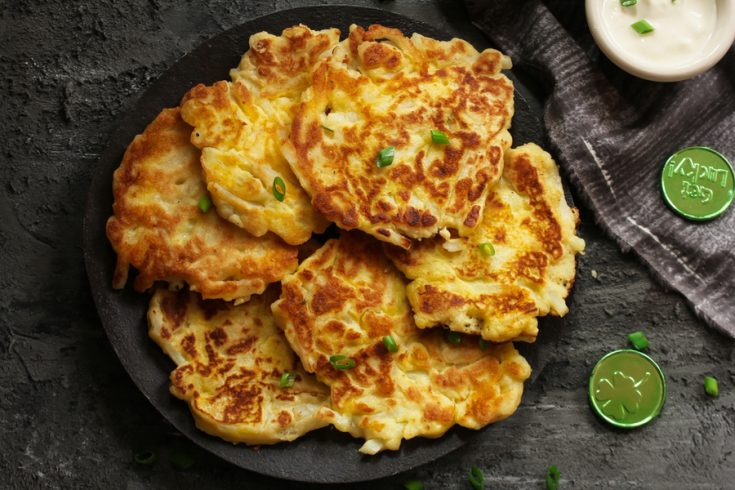
2. Boxty (Bacstaí)
The Irish Pancake
Boxty is proof that the Irish know how to make the most of potatoes. This traditional pancake-like dish hails from the northwest counties and is made from grated raw potatoes, mashed potatoes, flour, and water or buttermilk.
Boxty has been a staple of Irish cuisine for centuries, particularly in the northwest counties of Leitrim, Cavan, Mayo, and Donegal, where potatoes have been central to the diet since their introduction to Ireland in the late 16th century. The name “boxty” is believed to come from the Irish phrase “arán bocht tí”, meaning “poor house bread.” This suggests its origins lie in simple, rustic cooking—something made in poorer households where stretching ingredients was key.
Though oral tradition suggests boxty has been around for at least 300 years, one of the earliest written mentions of it appeared in the 1800s. An 1854 edition of The Household Encyclopedia describes it as a “potato cake” made by grating raw potatoes and mixing them with flour before frying or baking.
Flip it for me:
Gallagher’s Boxty House, Dublin – The definitive spot for all things boxty – they serve up 3 authentic varieties of boxty with a host of traditional and modern flavor combinations like Gaelic Boxty, Corn Beef Boxty Dumplings, Boxty Bread topped with carrot purée & black pudding crumb, and Boxty fries & aioli dip. Pair your food with a drink from the extensive Irish gin and whiskey menu.
Misunderstood Heron (Connemara) – A food truck that serves up a seasonal menu with stunning ocean views. As the menu is ever-changing there’s no guarantee for what you’ll find, except for a focus on seasonable, sustainable and foraged ingredients like Irish mussels with wild garlic and scratch-made pastries.
3. Soda Bread

The Table Staple
With its dense, slightly crumbly texture, Irish soda bread has been baked in hearth ovens for over 200 years. This no-yeast bread relies on baking soda as a leavening agent, making it quick and easy to prepare. Every family has their own take, often including ingredients like caraway seeds or honey.
Soda Bread shows up around 1830 with the introduction of bicarbonate of soda (also known as bread soda in Ireland), which provided a practical and reliable way to leaven bread without the need for yeast, which could be hard to source.
One of the earliest known published references to soda bread appears in an 1836 issue of The Farmer’s Magazine, a British agricultural journal. The article described how bicarbonate of soda mixed with sour milk could make bread rise without yeast. This technique became popular in Ireland because of the widespread use of soft wheat, which grows better in Ireland’s climate than the hard wheat needed for traditional yeast breads. Soft wheat works well with baking soda, making soda bread a natural fit for Irish kitchens.
Also look out for a sweeter variety called “Spotted Dog” with raisins or currants.
Slather it with butter:
Cremore Bakery (Dublin) – An award-winning bakery. In addition to soda bread and Irish brown bread, the bakery makes traditional cream cakes.
Soda Cakes (Limerick) – A local’s favorite bakery with all the Irish specialties (79 Sexton St N, Thomondgate).
Hands-On Experience:
Speltbakers (Kilkenny) – a bakery with fine Irish breads that also offers baking courses – contact them directly for class options and more info. (Old House, Bramblestown, Gowran, Co. Kilkenny)
4. Black and White Pudding
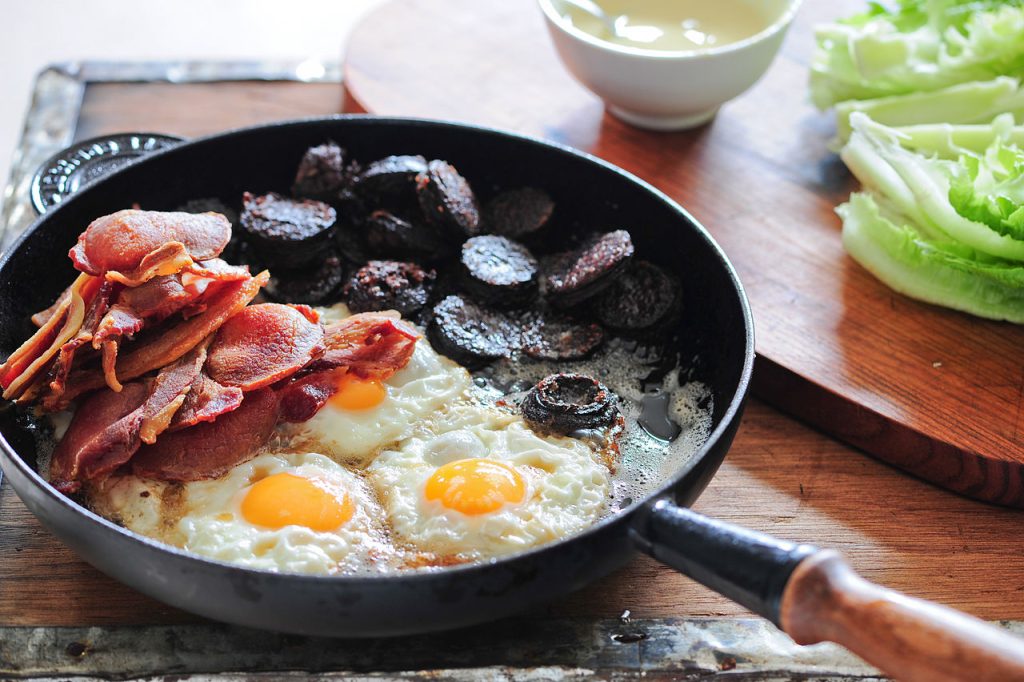
Yum, Blood Sausage
Black pudding (blood sausage) can be found across the European continent, but Irish black pudding has some unique characteristics. One of the most defining features of Irish black pudding is the use of oatmeal as a primary filler instead of bread, rice, or barley, which are more common in other blood sausages. This gives Irish black pudding a denser, drier texture compared to the softer, creamier consistency of French or Spanish versions. It’s also flavored simply, with onion and nutmeg or allspice, as opposed to the wine and herb infused varieties common in other cultures.
There are different varieties of blood sausage – for example drisheen, which hails from Cork, but is popular all over.
Since Irish pudding is a little drier, it lends itself to being boiled and then fried, and making excellent sandwich fillings. Irish white pudding is similar, just without the blood. Both can be found as part of a true full Irish breakfast.
Feeling carnivorous:
McCarthy’s of Kanturk – This shop makes an award-winning black pudding that was served to Queen Elizabeth at a banquette. Check the website for retail outlets that sell it (mostly in Cork and Dublin) or find it as part of a full Irish breakfast at cafes like the Farmgate Cafe (Cork). (At the Farmgate you can also find another Cork specialty – crubeens – pig trotters.)
5. Coddle

Dublin’s Classic
Coddle was so named because the ingredients were never fried, but cooked gently over time – something that could be left on the stove for long hours so the working-class could come home to a hot meal. Traditionally made with layers of sausages, bacon, potatoes, and onions, it’s slow-cooked in broth until everything melds into one savory, spoonable delight. It’s said to have been a favorite of writers like James Joyce and Jonathan Swift.
Coddle is one of the few distinctly “Dublin” dishes, with origins that date back to the 18th century. The dish became a staple in the homes of working-class Dubliners, particularly in The Liberties, one of Dublin’s oldest and most historically significant neighborhoods.
Where to Try It:
John Kavanagh the Graveggers (Dublin) – Winning the award for the best named pub in Dublin (wouldn’t you think?) this joint is actually situated next to Glasnevin Cemetery. It’s a real locals-favorite type of place, cozy and historic, with traditional Irish dishes, such as Beef Barley Stew and Coddle soup.
The Hairy Lemon (Dublin) – Another brilliantly named pub, also serving up a great warming bowl of Coddle.
The Pig’s Ear (Dublin) – For an elevated version, The Pig’s Ear serves Irish classics with a Michelin-level upgrade.
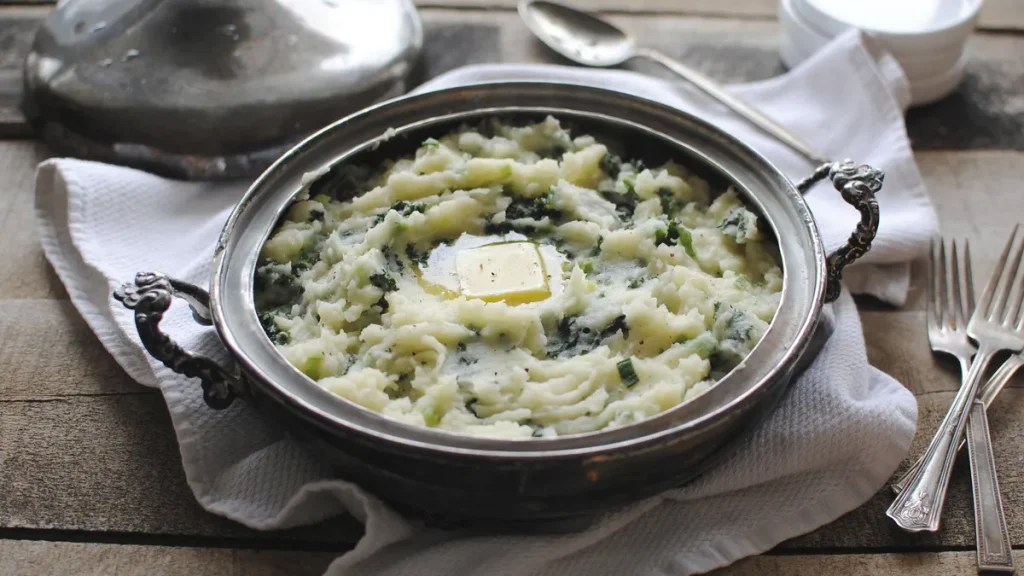
6. Colcannon
Mashed Potatoes, But Better
Colcannon is one of Ireland’s most famous comfort foods, a simple yet deeply meaningful dish of mashed potatoes mixed with cabbage or kale, plenty of butter, and sometimes scallions or onions. Historically, it was eaten on Halloween, with charms hidden inside predicting one’s fortune.
In rural Ireland, young, unmarried women would use colcannon as part of divination rituals. One tradition involved putting a spoonful of colcannon into a stocking and hanging it on the front door. The first man to walk through the door was said to become her husband!
Another custom involved placing a spoonful of colcannon under a girl’s pillow on Halloween night, believing she would dream of her future husband. (A bit messy, but worth a shot!)
On Halloween, don’t forget to leave out a portion for the fairies!
Butter Me Up:
Oliver St. John Gogarty (Dublin) – Live music, white tablecloths, traditional Irish fare.
Hands-On Experience:
The Irish Food Trail, Dublin – A guided tasting tour through the city’s best traditional dishes.
7. Fresh Oysters

The Taste of Ireland’s Coastline
Ireland’s cold Atlantic waters produce some of the finest oysters in the world, particularly from Galway Bay. Whether enjoyed raw with a squeeze of lemon or grilled with butter and seaweed, they’re a must.
Savor me:
Moran’s Oyster Cottage, Galway – An institution for fresh oysters – dating back over 200 years.
Hands-On Experience:
Flaggy Shore Oyster Farm Tour, Clare – In a 90 minute class learn about oysters and their life cycle and let an expert instruct you in proper shucking.
8. Barm Brack
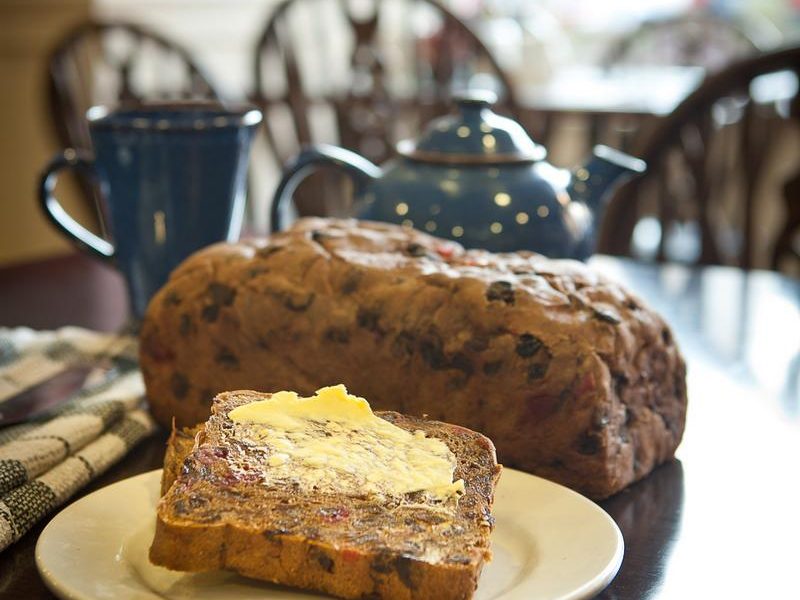
Sweet, Fortune-Telling Bread
Barm Brack is a slightly sweet loaf filled with dried fruit and a hint of whiskey. Traditionally eaten at Halloween, each loaf contains symbolic charms predicting the eater’s future. Unlike soda bread, which uses baking soda as a leavening agent, barm brack is a yeast-based bread, meaning it requires proofing before baking.
Barm Brack is deeply tied to Samhain (the ancient Irish festival that inspired Halloween). Traditionally, various charms were baked into the loaf, each carrying a different fortune for the person who found it in their slice.
Traditional Charms:
A Ring 💍 – You will get married soon.
A Coin 🪙 – Wealth or good fortune is coming your way.
A Pea 🥜 – You will not marry this year.
A Stick 🪵 – Trouble ahead, possibly disputes.
A Piece of Cloth (Rag) 🏴 – Financial hardship or bad luck.
A Thimble 🧵 – A life of spinsterhood (for women).
This custom was similar to King Cake traditions in Louisiana or Christmas Pudding in England, where hidden objects predict one’s future. Though many modern versions no longer include these charms (due to choking hazards!), some Irish families still continue the tradition.
Charm Me:
Hickey’s Bakery – order from this Clonmel bake shop famous for its Barm Brack.
Before we go, a few other places to check out that we recommend:
The Woollen Mills, Dublin – A modern Irish eatery overlooking the River Liffey.
Ard Bia at Nimmos, Galway – A farm-to-table haven that prioritizes local ingredients.
The Brazen Head, Dublin – Ireland’s oldest pub, serving up some old school Irish specialties.
L Mulligan Grocer, Dublin – A gastropub with locally sourced ingredients.
Chapter One, Dublin – A Michelin-starred twist on Irish classics.
Whether you’re eating your way through Dublin’s lively food scene or discovering Ireland’s hidden gems, these dishes tell the story of a land rich in history, tradition, and flavor. Sláinte!